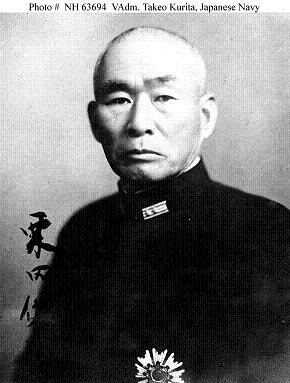![]() The Pacific War Online Encyclopedia
The Pacific War Online Encyclopedia
|
| Previous: Kurisu Takeo | Table of Contents | Next: Kurobe |

Naval Historical Center #NH-63694
Tremendous controversy swirls around the figure of Kurita Takeo. He was born in Ibaraki prefecture to a scholarly family and graduated from the Japanese naval academy in 1910 and from the Naval Staff College in 1917. He was a torpedo specialist who spent much time in destroyers between the wars. He was promoted to flag rank in 1938.
A rear admiral commanding Japan's Cruiser Division 7 at the start of the Pacific War, Kurita participated in the Philippines invasion, then accompanied Ozawa on a raid into the Indian Ocean that destroyed 23 merchant ships of 112,312 tons. During the Guadalcanal campaign, Kurita led his battleships on a bombardment of Henderson Field that nearly put the field out of business, and which was remembered ever after to the American survivors as The Night.
Kurita commanded C Force of the Mobile Fleet during the Battle of the Philippine Sea, but tactical control of the force was in the hands of Obayashi Sueo.
Kurita commanded 2 Fleet, the pride of Japan's surface forces, by the time of the American liberation of the Philippines. Kurita doggedly endured the loss of his flagship and another cruiser to submarine attack, and the superbattleship Musashi to air attack, as he tried to make his rendezvous with Nishimura's battleship force off Leyte to destroy the American invasion forces. He emerged from San Bernardino Strait to find himself up against what he took to be the main carrier force of Halsey's 3 Fleet, screened by cruisers and destroyers. In fact, he was facing three task groups of slow, poorly-armed escort carriers screened by destroyers and destroyer escorts. But the Americans fought hard, and after losing three more cruisers Kurita had had enough and turned back.
Kurita was an old sea dog who spent most of his career at sea rather than on shore assignments. He rose to high command mostly by keeping a low profile and thereby staying out of trouble. He seems not to have bought into the exaggerated Bushido of the war years, and it is alleged that, near the end of his long life, he confessed to an associate that he had retreated from Leyte Gulf because he could not see the point of taking the sailors of his fleet to a useless death. Some Japanese historians have claimed that we was deliberately set up as a scapegoat for naval defeat. After the Leyte battle, he was reassigned as superintendent of the naval academy at Eta Jima, and he seems to have used this opportunity to prepare the cadets to be peacetime leaders of postwar Japan.
Boatner tells us that an American journalist in
1947 described him as a "trim, hazel-eyed ... little man with a
winning
smile now living in poverty in a wood-and-paper shack on Tokyo's
outskirts." He worked closely with American historians attempting
to
reconstruct the history of the war from the Japanese perspective.
| 1889-4-28 | born | |
| 1910-7-18
|
Midshipman
|
Graduates from Naval Academy, standing 28th in a class of 149. Assigned to Kasagi |
| 1911-3-11 | Niitaka | |
| 1911-12-1 | Ensign |
Tatsuta |
| 1912-12-1 | Torpedo
School Basic Course |
|
| 1913-5-24 | Gunnery
School Basic Course |
|
| 1913-12-1 | Lieutenant junior
grade |
Satsuma |
| 1915-3-17 | Sakaki | |
| 1915-6-30 | Iwate | |
| 1916-9-1 | 3 Naval
District |
|
| 1916-12-1 | Lieutenant | Tone |
| 1917-8-9 | Kaba | |
| 1917-12-1 | Naval College B Course |
|
| 1918-4-15 | Torpedo School Advanced Course |
|
| 1918-12-1 | Executive officer, Minekaze | |
| 1919-6-1 | Staff, 5 Squadron |
|
| 1920-3-1 | Executive officer, Yakaze | |
| 1920-12-1 | Commander, Shigure | |
| 1921-6-8 | Awaiting assignment |
|
| 1921-8-6 | Commander, Oite | |
| 1921-9-6 | Staff, 4 Squadron |
|
| 1921-11-20 | Instructor, Torpedo School |
|
| 1922-12-1 | Lieutenant
commander |
|
| 1924-12-1 | Commander, DD-2 | |
| 1925-12-2 | Commander, Hagi | |
| 1926-12-1 | Commander, Hamakaze | |
| 1927-12-1 | Commander | Commander, Urakaze |
| 1928-12-10 | Instructor, Torpedo School |
|
| 1930-3-8 | Staff, Torpedo Research Division |
|
| 1930-11-15 | Commander, Destroyer Division 25 |
|
| 1932-4-1 | 1 Naval
District |
|
| 1932-5-19 | Commander, Destroyer Division 10 |
|
| 1932-12-1 | Captain | Commander, Destroyer Division 12 |
| 1934-11-15 | Commander, Abukuma | |
| 1935-11-15 | Chief instructor, Torpedo School |
|
| 1937-12-1 | Commander, Kongo | |
| 1938-11-15 | Rear admiral |
Commander, Destroyer Squadron 1 |
| 1939-11-25 | Commander, Destroyer Squadron 4 |
|
| 1940-11-1 | Commander, Cruiser
Division 7 |
|
| 1942-5-1 | Vice admiral |
|
| 1942-6-25 | Staff, Combined
Fleet |
|
| 1942-7-12 | Commander, Battleship
Division 3 |
|
| 1943-8-9 | Commander, 2 Fleet |
|
| 1945-1-15 | Director, Naval Academy |
|
| 1945-10-1 | Department of Navigation |
|
| 1945-10-5 | Retires |
|
| 1977-12-19 | Dies |
References
Materials
of
IJN (accessed 2007-12-6)
The Pacific War Online Encyclopedia © 2007, 2012 by Kent G. Budge. Index